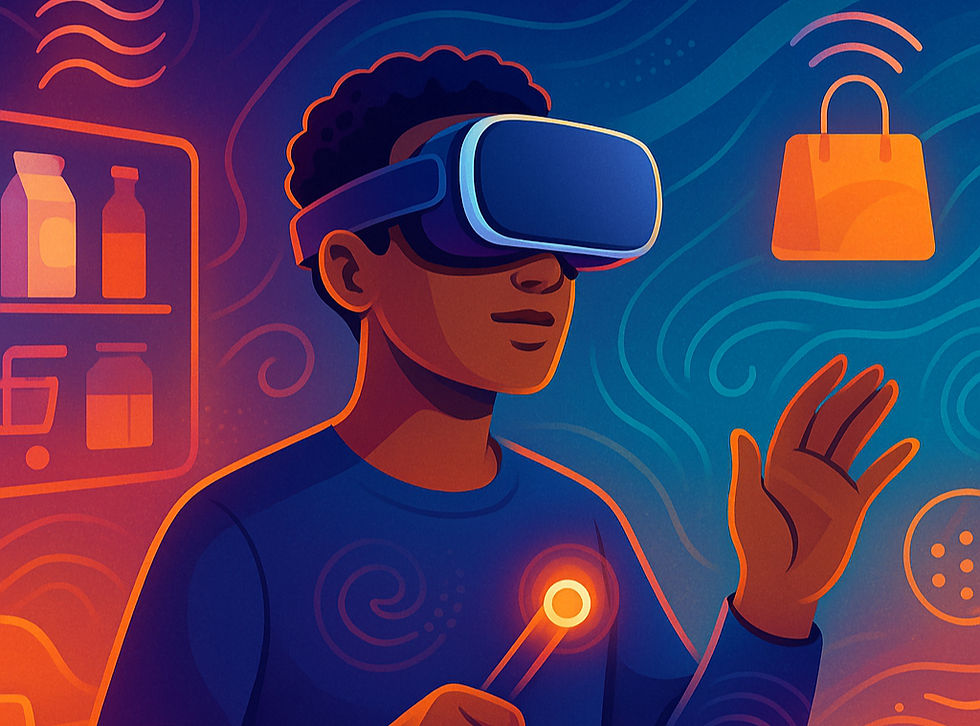Beyond the Headset: What Research Says About the Future of VR Shopping
- Nilotpal Biswas
- Aug 28
- 4 min read

Virtual Reality (VR) is quickly moving from the pages of science fiction to our living rooms and, increasingly, our shopping carts. It's considered one of today's technological megatrends, with a market value projected to hit nearly $50 billion by 2023. Retail giants like Walmart, IKEA, Alibaba, and Amazon are already pioneering VR experiences, from virtual showrooms to VR kiosks, hinting at a radical transformation of e-commerce. But beyond the hype, what do we actually know about shopping in virtual reality? A comprehensive literature review by Nannan Xi and Juho Hamari, titled "Shopping in virtual reality: A literature review and future agenda," systematically analyzes 72 research papers to give us a clearer picture.
A central point from the review is that we need a broader understanding of what "Virtual Reality" truly is. For years, the term has been loosely applied to everything from 3D interfaces to virtual worlds like Second Life. The authors argue that a myopic focus on specific hardware, like the current wave of head-mounted displays (HMDs), misses the bigger picture. They propose a more encompassing, sense-agnostic definition: VR is any technology used for "substituting the perceived reality". This simple but powerful idea reframes VR not just as a visual medium, but as a holistic technology capable of engaging all our senses.
The review synthesizes findings from 83 individual studies, the majority of which were published between 2018 and 2020, highlighting just how new this field is. Researchers have most frequently used experiments to compare VR with other environments. These studies often take place in simulated retail stores or supermarkets, with food being the most common product category investigated. The technology used varies, but HMDs like the HTC Vive and Oculus Rift are the most prominent visual output devices. To interact with these virtual worlds, users are most often equipped with handheld VR controllers, though everything from gamepads to eye-tracking has been employed.
So, does VR actually make for a better shopping trip? The results are promising, but mixed. Several studies confirm that VR can generate higher experiential value and more positive outcomes compared to looking at pictures or videos online. In some cases, the experience is so effective that it closely mimics a real, physical store. However, VR isn't always a clear winner; one study found that searching for products in a virtual environment was actually less efficient than in a physical one. This suggests that the design of the interface and interaction is crucial. For instance, input methods like a "magic wand" controller have been found to be more efficient for shopping tasks than other techniques.
Perhaps the most exciting findings relate to the power of multisensory experiences. The review notes that while VR is predominantly visual right now, technologies that incorporate other senses can significantly deepen the experience. One study found that adding olfactory stimuli, or the sense of smell, enhanced participants' memory of a product's name and location. In another, incorporating a virtual shopping assistant's touch led participants to spend more time and money in the store. While added sound can improve realism, its overall effect on the shopping experience seems to be less pronounced. These findings underscore that a truly immersive shopping future may appeal to more than just our eyes.
Looking ahead, the authors argue that the true potential of VR shopping lies not in perfectly mimicking brick-and-mortar stores, but in creating entirely new experiences that are impossible in the real world. They identify three key features that will define the future VR shopping experience:
Non-consequentiality, where the digital nature of products means shoppers can experiment freely, disassembling furniture or test-driving a car at impossible speeds, without any real-world risk or cost.
Disentanglement, which is the ability to remap sensory properties, such as making a bulky machine feel as light as a feather.
Polyidentity, describes how users can adopt different virtual avatars and identities, which in turn influences their shopping behavior and attitudes in complex ways.
The takeaways from this research offer a fascinating roadmap for designing a VR shopping application for visually impaired people. The paper’s core argument, that VR is about "substituting the perceived reality" and is not exclusively visual, is paramount here. For a user who is visually impaired, the "reality" being substituted is not a visual one. Instead, VR technology can create a rich, navigable, and immersive world through other senses. The review’s findings on multisensory tech provide a direct blueprint: an application could use high-fidelity spatial audio to create a sense of the store's layout and ambiance, improving perceived realism. Haptic feedback devices could allow users to "feel" the texture, shape, and weight of products, while a virtual assistant's touch could guide them through the store, potentially making the experience more engaging. Olfactory technology could even be used to convey the scent of fresh produce or a leather handbag, enhancing product memory and evaluation. By focusing on these non-visual stimuli, designers can create a VR experience that is not just accessible, but genuinely powerful and effective for a new audience.
Reference
Xi, N. and Hamari, J., 2021. Shopping in virtual reality: A literature review and future agenda. Journal of Business Research, 134, pp.37-58.



Comments